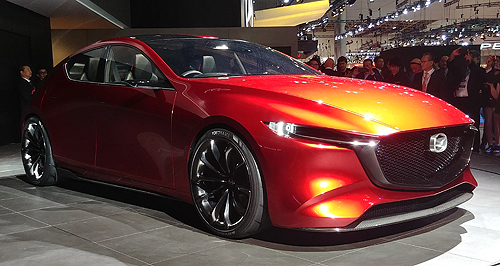Future models - Mazda - Mazda3Tokyo show: Kai concept signals new Mazda3Looks to Kai for: Mazda reckons its new Kai concept, which points to the styling of its next-generation Mazda3 small car, is a hatchback in its perfect form. New-generation SkyActiv-X Mazda3 hatchback heralded by slick Kai concept26 Oct 2017 By TUNG NGUYEN in TOKYO MAZDA’S stunning Kai concept revealed at the Tokyo motor show this week previews the sportier and more mature design direction and advanced technology of its all-important, best-selling Mazda3 small car, the new generation of which is expected to reach production in 2019. Billed as the “ideal combustion-engine-powered car” by Mazda Motor Corporation (MMC) president and CEO Masamachi Kogai, the Kai concept is built on the Japanese brand’s new SkyActiv-Vehicle Architecture and is powered by its pioneering SkyActiv-X spark-less compression-ignition engine. “This compact hatchback concept embodies everything Mazda is aiming for in its next generation of models,” Mr Kogai said at the Kai’s unveiling in Tokyo. Adopting the same evolution in Mazda’s Kodo design language as the Vision Coupe concept also presented at the show, the Kai sports smooth, flowing lines throughout. Sheetmetal flourishes such as kinks and contours are kept to a minimum in a bid to mature the current Mazda3’s design and place an emphasis on blank surfaces. What bodywork design flairs remain – including a subtle shoulder line and raised bonnet – give the Kai concept a dynamic and sporty stance, which according to MMC chief designer Yasutake Tsuchida is no accident. “What we intended with this introduction of this car is that we wanted to imbue it with more of the sporty feel than you would expect in a hatchback,” he said. “And what I feel, and what we hoped to express, in this car design was that it was not what you would have seen in the previous generations, very juvenile and ‘fresh’ – that is what we had before. “But with this one, I’m hoping, and it was certainly the intention, to have more sporty, mature design for this car.” From the front, the Kai concept wears slim headlights and Mazda’s prominent grille, while its front-wheel-drive layout is subtly alluded to with muscular fenders. Giving the Kai concept a more seamless look, the front windscreen extends to the roof where the top body panel partitions the driver’s and passenger’s glass ceiling. The smooth lines are continued in profile, where the next-generation Mazda3 progenitor features flat panels and slightly contoured front doors to catch light and add dynamism. From behind, the Kai concept wears a high-riding bumper with integrated dual exhaust pipes for a squat stance, and aggressively styled tail-lights. The rear hatch, while small and high, includes a rear spoiler finished in a dark metallic colour to contrast with the red duco, and a sports bodykit is fitted all around. The wheelarches house 20-inch alloys measuring nine inches wide and shod in 245/35 rubber, with large drilled brake discs tucked inside. Although the Kai looks racetrack-ready with all these sporting elements, Mr Tsuchida would not comment on whether the concept alluded to the return of the high-performance MPS badge for Mazda’s next-generation small car. However, he did admit Honda’s new Civic Type R could be somewhat considered as the Kai concept’s opposite given the Type R is adorned with in-your-face, albeit functional, aerodynamic components including a monster rear wing, roof-mounted vortex generators and three exhaust outlets. Inside, the Kai concept has many of the same components used in the Vision Coupe – a pointer to the next-generation Mazda6 mid-sizer – including dashboard-integrated screens and simple instrumentation. Measuring 4420mm long, 1855mm wide and 1375mm high, the Kai concept is 50mm shorter and 90mm lower than the current Mazda3 hatchback, but is also 60mm wider. It also has a 50mm longer wheelbase. When it arrives in production form, the next-generation Mazda3 will be the first vehicle built on the brand’s new SkyActiv-Vehicle Architecture, which will proliferate across the company range of passenger cars, SUVs and sports models. A major advantage in the new platform is the improvement of noise, vibration and harshness (NVH) levels, according to Mazda, while each vehicle will retain the brand’s signature sharp dynamics. While still too far out to confirm exact specifications, the new Mazda3 is expected to carry over the current model’s SkyActiv-G 2.0- and 2.5-litre direct-injection petrol engines with minor updates and will be topped by the new compression-ignition SkyActiv-X powerplant.  Read more25th of October 2017  Tokyo show: Fresh Mazdas cast in new Kodo designNew-generation Mazda models to wear ‘less is more’ updated Kodo design language25th of October 2017  Tokyo show: New-gen Mazda6 takes shapeMazda matures Kodo design with Mazda6-previewing four-door Vision Coupe concept11th of October 2017  Tokyo show: Mazda teases two conceptsShades of next Mazda3 in SkyActiv-X hatchback concept destined for Tokyo show11th of September 2017  Bumpy road to Mazda compression-ignition petrol unitMultiple problems kept Mazda’s boffins busy for years before the system workedMazda3 pricing
Motor industry news |
Click to shareMazda modelsResearch Mazda Mazda3 pricing
Motor industry news |






































Facebook Twitter Instagram